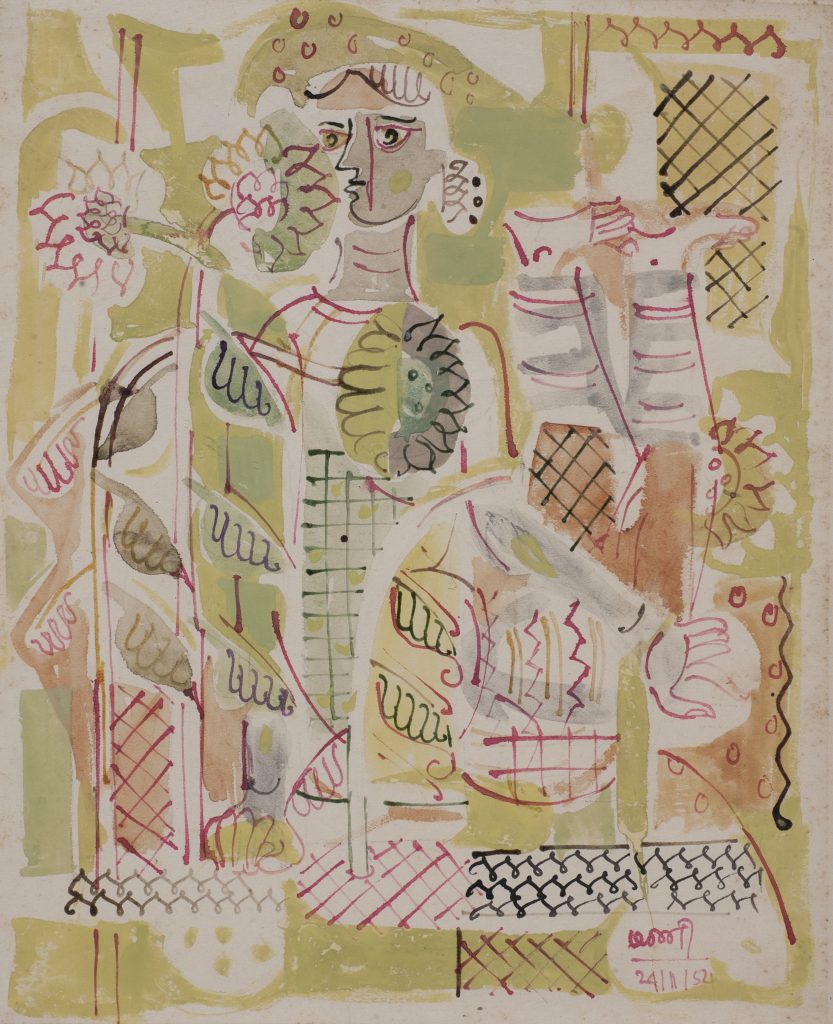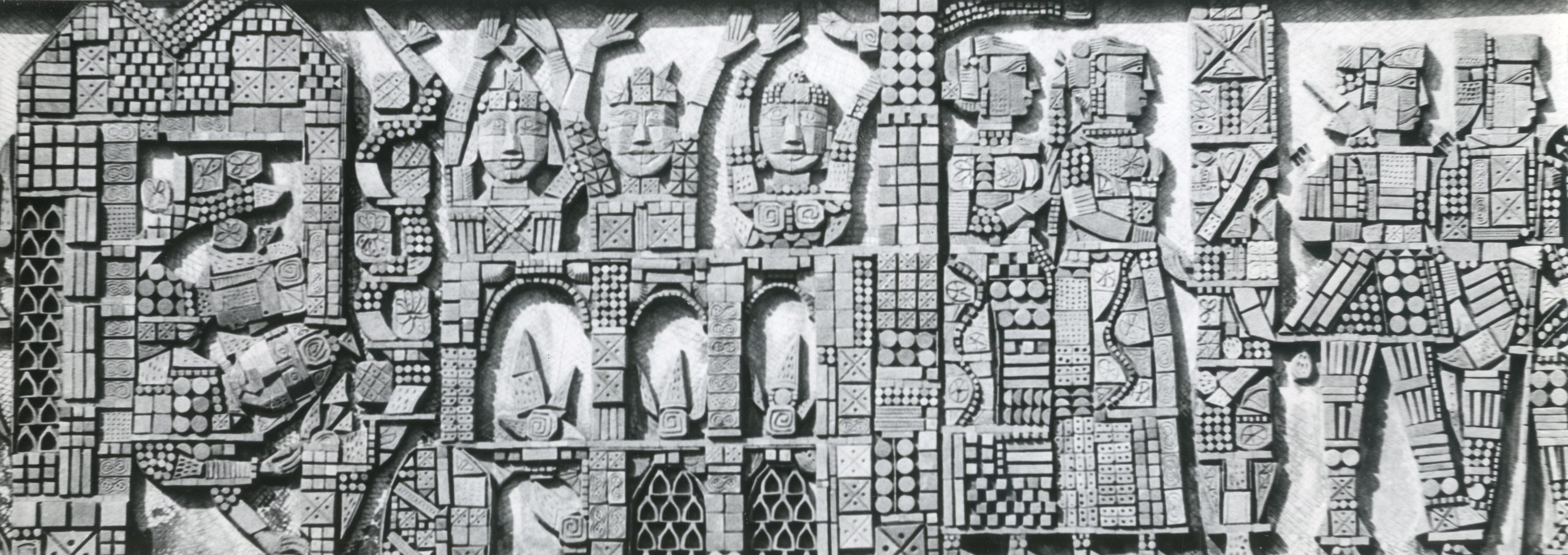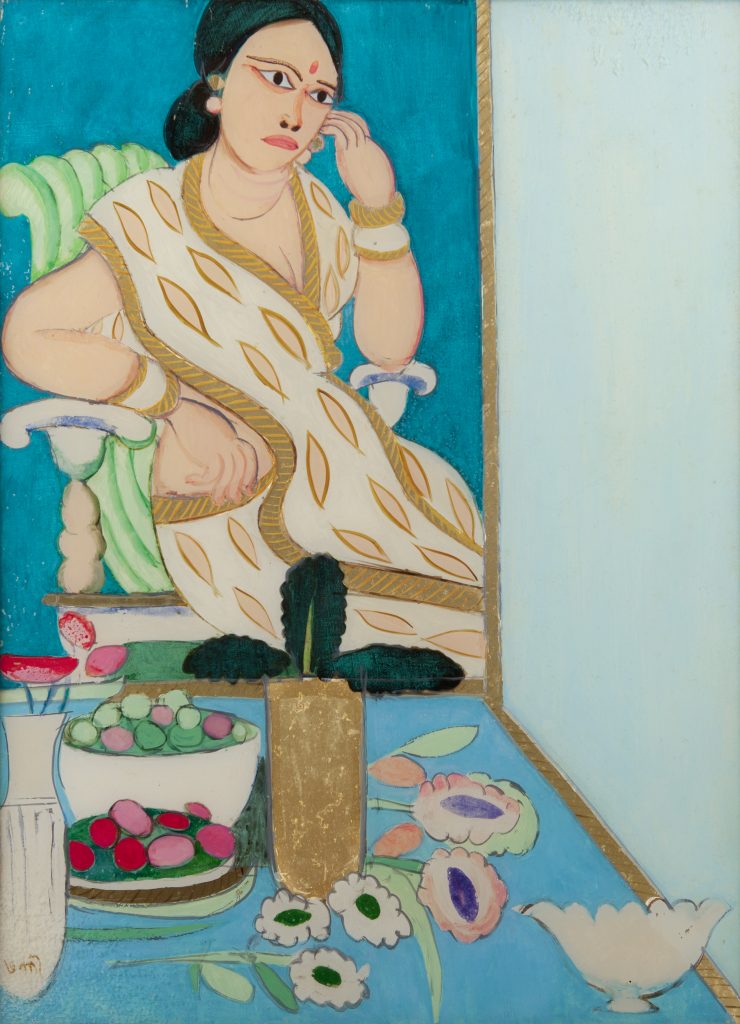Blogs
Understanding KG Subramanyan through Six Pivotal Artworks
Sanjana Srinivasan
From paintings to sculptures and murals, KG Subramanyan’s oeuvre spans an incredible range of media and techniques, making him one of the most significant modernists.
An Indian modernist best known for his versatility, KG Subramanyan’s work spans an incredible range of media and techniques — from painting, sculpture, printmaking to murals, writing, and illustration. In an age of increasing specialisation and disconnect, his work offers a means of connection between diverse aspects of making, be it modern and traditional, western and eastern, art and craft.
Fondly remembered as ‘Mani da,’ Subramanyan was also an extraordinary teacher and an inspiration for several generations of artists. Here are six pivotal artworks that allow a deeper understanding of Subramanyan’s artistic concerns and journey.
Untitled (Girl with Sunflower), 1952

Untitled (Girl with Sunflower), K.G. Subramanyan, 1952, Watercolour on paper, Collection and image courtesy: Kiran Nadar Museum of Art, New Delhi
This early work is reflective of Subramanyan’s training at Kala Bhavana, Santiniketan. Subramanyan joined Kala Bhavana in 1944 after being barred from the Presidency College in Madras (not to mention all other governmental institutions throughout the country) for having participated in the freedom struggle by picketing the Government Secretariat. As a result, he was jailed for six months at the Allipuram Camp Jail. However, after writing to Nandalal Bose, Subramanyan’s brother was able to secure him a seat at Kala Bhavana.
The curriculum at Santiniketan was well suited to Subramanyan’s temperament and beliefs — it was non-orthodox, rooted in Indian art and culture, radical even. At Santiniketan, Subramanyan learnt to experiment with a wide range of materials and techniques including mural making under the guidance of celebrated artists such as Ramkinkar Baij and Benode Behari Mukherjee.
Studio Still-Life, 1962

Studio Still Life, KG Subramanyan, 1962, Oil on Canvas, Image Courtesy: Piramal Museum of Art, Mumbai
Between 1961–62, Subramanyan created a large body of still lifes. These paintings of bottles, tableware, painting materials and other things mark a shift in Subramanyan’s style and visual language. Subramanyan’s art at this point took on a distinctly post-Cubist flavour. His texture-rich still lifes of this period are experiments in blending Synthetic Cubism with Oriental traditions and techniques. But they also trace their inspiration to Subramanyan’s two-year stint at the Handloom Board, Bombay, where he was the Deputy Director of Design. The exposure to an array of local crafts, which Subramanyan considered to be ‘art’ (as opposed to ‘craft’), opened up immense possibilities in his practice.
The King of the Dark Chamber, 1962–63

King of the Dark Chamber (partial), K. G. Subramanyan, Lucknow, 1963, Mural, Image courtesy: K. G. Subramanyan Archive, Asia Art Archive Collections.
Around his still life period, Subramanyan joined the faculty at M.S. University, Baroda. Apart from teaching, he used this opportunity to participate in art fairs. Not limiting his creativity to just canvases, he created masks, wooden and clay toys, costumes, and stage sets for theatre plays. He was commissioned to create a mural at Ravindralaya, the performing arts theatre in Lucknow. The terracotta mural, titled The King of the Dark Chamber after a play by Rabindranath Tagore, was Subramanyan’s most ambitious yet.
While the idea was to draw inspiration from ancient temple murals, the work was also conceived like a post-Cubist collage. He went on to create many more such unique murals, depicting dismembered human figures affected by war, goddesses, fertility figures, and mythological characters in various states of animation and gestures.
Portrait Gallery, c. 1960s

Portrait Gallery, K.G. Subramanyan, c. 1960s, Oil on canvas, MAC.02926
In 1966, Subramanyan was awarded the Rockefeller scholarship through which he travelled to New York City. There, he learnt all about the western modernist emblem — the grid. But he used the notion of the grid in his art for the first time for practical reasons. Due to space constraints in the studio where he lived, Subramanyan took to new compositional devices, imagining his works as fragmented diptychs and triptychs until it became the defining aspect of his visual language in the years to come. The grid became the ‘window’ and the space of the table (of the still life) transitioned into domestic interiors, studios, shop windows and streets.
Woman in the Blue Room, 1981

Woman in the Blue Room, K.G. Subramanyan, 1981, Painted glass, MAC.00695
In 1977, Subramanyan participated in an art fair at Santiniketan and created his first paintings on glass. Inspired by traditional glass paintings of the colonial era, he began to render colourful images on both glass and acrylic sheets. He even drew inspiration from other traditions such as the Kalighat Pat and Ukiyo-e prints for these. Soon, his images — of largely women — began to take shape into events, narratives and stories as Subramanyan tried to converge his experiences of the outside world with his inner world. From the late 1970s onwards, one can identify his unique visual language — colourful, fragmented or montage-like, carefully constructed yet spontaneous, decorative yet expressionist, and brimming with allegories.
Black and White Mural, Kala Bhavan, 2009–10

Black and White Mural (south-side detail), K. G. Subramanyan, Kala Bhavana, 2009–10, Image courtesy of K. G. Subramanyan Archive, Asia Art Archive Collections
This iconic work was painted over previous paintings rendered by Subramanyan himself at Santiniketan. Done late in his career, it embodies everything Subramanyan worked towards. It showcases Subramanyan’s polyvalent nature, wide-ranging interests in mythology, religion and local culture, and incredible draughtsmanship. Here is an artist who took what was around him, treated it as ‘art’ (a rarity during his time when many were looking towards the west or ancient past for inspiration) and came up with his own visual language.
To know more about KG Subramanyan’s expansive art practice, visit MAP’s latest exhibition in collaboration with Asia Art Archive India – Bahurupee in the Panorama: Writing and Artwork of KG Subramanyan.
Sanjana is a freelance art writer. Her articles have been published in Art India, Degree Critical and The Hindu MetroPlus.








